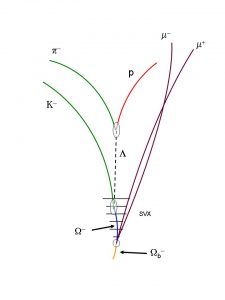Once produced, the Omega-sub-b (Ωb) particle travels about a third of a millimeter before it disintegrates into two intermediate particles called J/Psi (J/ψ) and Omega-minus (Ω-). The J/Psi then promptly decays into a pair of muons. The Omega-minus baryon, on the other hand, can travel several centimeters and occasionally be measured in the CDF silicon vertex detector. The particle decays into an unstable particle called a Lambda (Λ) baryon along with a long-lived kaon particle (K). The Lambda baryon, which has no electric charge, also can travel several centimeters prior to decaying into a proton (p) and a pion (π). Credit: CDF collaboration.

